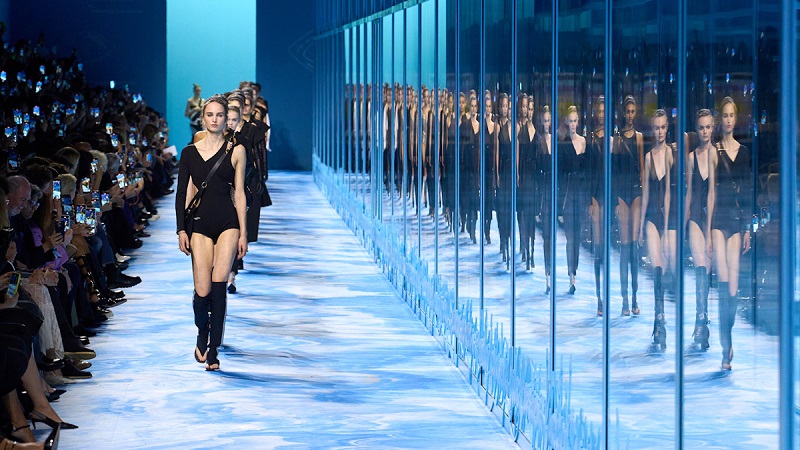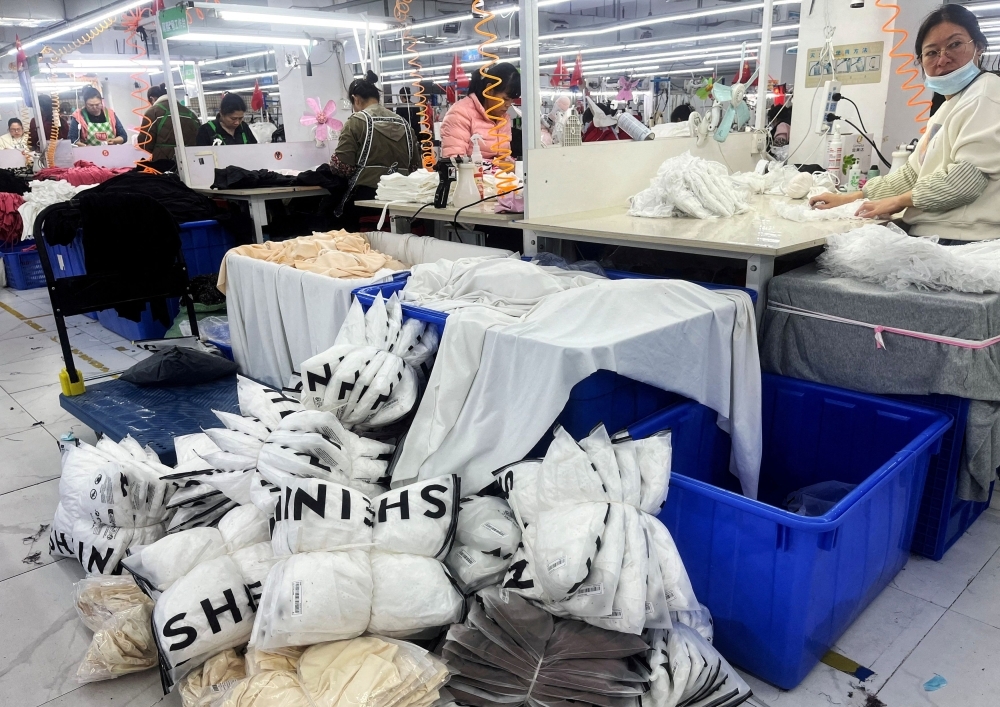FW
"The textile sector, contributes over 50 per cent to Pakistan’s exports, and now it is facing tough times. A textile package of Rs 180 billion was announced in January this year. Under the package, Rs 38 billion was allocated for exports while a meager Rs 3.5 billion has been disbursed as of now. Textile manufacturers are in a fix if they should continue production, even after knowing that they would make losses. All sub-sectors of the textile industry are running under capacity and 25-35 per cent of all projects have shut down."

The textile sector, contributes over 50 per cent to Pakistan’s exports, and now it is facing tough times. A textile package of Rs 180 billion was announced in January this year. Under the package, Rs 38 billion was allocated for exports while a meager Rs 3.5 billion has been disbursed as of now. Textile manufacturers are in a fix if they should continue production, even after knowing that they would make losses. All sub-sectors of the textile industry are running under capacity and 25-35 per cent of all projects have shut down. Only garments and made-ups sub-sectors have been able to sustain production.
Non-starter policies

The budget deficit is resulting in non-payment of sales tax refunds which is estimated at Rs 250 billion. The Finance Minister had promised to clear sales tax refunds by August 15, 2017. The Minister’s promise relates to the Refund Payment Orders (RPOs) issued by the Federal Board of Revenue (FBR) till April 30, 2017. Government policies regarding refunds, payment of incentives, under-invoicing and smuggling are adversely affecting the textile sector. If the government solves these three issues, it will give breathing space to this sector.
The entire system is virtually controlled by FBR’s auditors to the exclusion of every other officer. This results in harassment of the assesses, delay in issue of RPOs, uncalled for rejections of input taxes, not giving in writing reasons for such rejections, and their resultant unaccounted shenanigans. RPOs issued in July2016 have still not been cashed. This entire entangled system of refunds has snowballing effect on the cash flow of the textile sector. Rs250 billion is still stuck in refunds cost, and in interest amounting to Rs22 billion or 1.75 per cent of total textile exports to exporters.
Afghanistan imports raw materials under the ATT for industries that do not exist in Afghanistan and these raw materials end up in Pakistan without payment of import duties. These two factors have resulted in losses to the national exchequer, as well as resulted in the closure of industries, leading to unemployment. As a suggestion, the government should create a Special Directorate or Collectrate whose sole job should be to control underinvoicing.
"With a new avatar, this year’s Interfilière edition was all about new collaborations and closer alliance between the lingerie and swimwear show. Experimental work from St Martins School of Art, with students demonstrating new bio-materials, and even a French underwear brand called Spartan explaining men’s briefs with silver fibre to shield the wearer’s delicate parts from mobile phone radiation, offered innovative streaks of new age professionals."

With a new avatar, this year’s Interfilière edition was all about new collaborations and closer alliance between the lingerie and swimwear show. Experimental work from St Martins School of Art, with students demonstrating new bio-materials, and even a French underwear brand called Spartan explaining men’s briefs with silver fibre to shield the wearer’s delicate parts from mobile phone radiation, offered innovative streaks of new age professionals.
Prints reigning the closet
Like last year, prints were a hit this year too. A special exhibition was dedicated to print technologies, including 3D printing that can create innovative solutions. Dutch start-up brand Mesh demonstrated customisable, bespoke bras using scanning, 3D printing to prototype bras for customers. Creatures founder, Dan Walters described the overall print trend as being ‘full on print’ prints were also texturally very sensuous.

Collaborations were the spotlight during the entire event. For instance, Asahi Kasei and Wolford has been collaborating to improve the luxury hosiery line’s product range with the ‘Salad Collection of hosiery’ made with Roica’s Eco Smart Family of premium stretch fibres supporting Wolford’s Gold Certified Cradle to Cradle standards. This means the garment has an end of life certification that it can break down naturally without polluting the environment with harmful materials according to the Hohentein Environmental Compatibility Certification. The tights will be in shops for AW 18-19. Roica is also working with lace manufacturer Iluna to bring added value to ranges by luxury lingerie brand Aubade.
The Willy Hermann/Invista partnership created the ‘Casual Bra’ project. Bralettes for smaller cup sizes and wire-free bras for bigger cup-sizes, as well as performance fabrics for sports bras have been major focusses for Willy Hermann. Using differing percentages of Lycra has been part of the answer, with percentages as high as 48 per cent Lycra for the natural support ranges.
In intimate wear, comfort is one of the most important parameter. Shape wear companies are taking note of this with the use of control panels and using fabrics, fibres and design to create shape wear that supports, moulds, contours without constriction and excessive compression. Easy to apply, wear and wash garments add value to the wardrobe.
Athleisure has also been creating a new wave of growth for intimate wear companies. Work Leisure engages with professional’s 360 lifestyle, where there is a need for clothes that can be worn to run or bike to work and then head to a meeting. Work clothes are becoming more casual and demands for specialist fibres is growing, with a savvy consumer with money to spend. Comfort, performance and good design are essential to this trend, making sports clothes integrate into a working wardrobe.
Fabric trends
In terms of colour and fabric trends, there were the usual forecasts for colours in lingerie, split between the more romantic and the more adventurous for 2019. Soft nude and pastel tones, including soft blues, peaches, with a chalky finish, lace both as trim and a main fabric is important. Sofileta is producing a nanofabric of 60gsm only beaten by Willy Herman’s fabric weighing in at a feather light 50gsm.
Bishchoff led the way in 3D fabrics, fishnets adorned with notions, bobbles, and ribbons, stand out lace florals and embroidery. Ribbons, zippers and other notions were also very expressionistic and much more creative than before. Elastic trips seem to be centre of attraction. Elastic knitters made headlines with lacy edging, intricate visual designs that put elastic centre stage, a big leap forward for the elastic trim industry.
India is preparing a Rs 2,600 crore incentive package for the leather and footwear sector to boost exports and job creation. The package, which includes both tax and non-tax benefits, was prepared on the lines of the steps announced for the textile sector last year. Major players include: Bata, Liberty Shoes, Mirza and Relaxo Footwear.
The industry is mainly dominated by products made of synthetic leather. It accounts for about 90 per cent of the total leather manufacturing in the country. About 30 lakh people are directly employed in the sector. The aim is to increase the sector’s exports to 15 billion dollars by 2020 from the current seven billion dollars.
In the global market, China is giving a tough competition to Indian leather manufacturers in terms of pricing. The growth in the Indian fashion and lifestyle market has given an impetus to the footwear industry as well. From a basic need-based industry, it has become an evolving fashion and style category.
India is the second largest footwear producer in the world, with footwear production accounting for approximately nine per cent of the global annual production – 22 billion pairs as compared to China, which produces over 60 per cent of the global production.
Ahmedabad is gearing up to host Garment Technology Expo (GTE-’17) from August 18 to 20, 2017.
This is a garment, knitting and printing technology exhibition. GTE 2017 will see around 260 exhibiting companies and brands showcasing a rich mix of technologies in apparel manufacturing, knitting and printing. The trade show will see renowned Indian and international companies from across the textile and apparel value chain exhibiting CAD/CAM, sewing, knitting machines and embroidery machines, laundry and quilting machines, fusing machines, finishing equipment, spreading and cutting machines, printing and packaging machines, fancy yarn machines, dyes, chemicals, fabrics, fancy yarns, software solutions, spares and attachments, accessories and trims, testing equipment and support services.
This, the silver jubilee edition of GTE, promises to be a must-visit destination for buyers from the textile and apparel industry.
Gujarat is popularly termed as the textile state of India and Ahmedabad is the hub of the garment and made-up fabrication of the western region. Gujarat is a one-point sourcing hub for all kinds of textiles, with one of the largest concentrations of textiles in India. The show will showcase the ever growing and dynamic and vibrant industry of Gujarat. GTE initiated in 2001 and has already conducted successfully 24 editions across the nation.
By outsourcing jeans production to contractors in developing countries, apparel companies are able to avoid accountability for the carbon emissions created by manufacturing their products. Climate pollution is likely to have severe impact on developing countries, like Bangladesh, Vietnam, and China, that produce the world’s clothes. People who are already being exploited by jeans makers seeking cheap labor and lax pollution laws outside of the United States are also being disproportionately impacted by climate pollution.
The clothing industry is the second largest polluter in the world, second only to oil. The apparel industry generates about three per cent of global greenhouse gas emissions, roughly equal to the climate pollution created by putting 163 million new passenger cars on the road. One pair of denim jeans produces 44 pounds of greenhouse gas emissions equivalent to driving a car almost 48 miles.
Filthy Fashion, a newly-launched campaign from Stand. earth in partnership with Sum of Us, an international corporate watchdog, targets seven denim brands including Calvin Klein, Tommy Hilfiger, Guess, Express, American Eagle Outfitters, Wrangler, and Lee for ignoring their own impact in regard to the greenhouse gas emissions created by apparel manufacturing.
The groups are calling on all seven brands to take responsibility for their devastating environmental impacts and immediately begin addressing their greenhouse gas emissions created by denim manufacturing.
London Textile Fair was held from July 19 to 20, 2017 and the ongoing uncertainty surrounding Brexit did not discourage buyers from turning up in full force. More than 470 exhibitors displayed textiles, accessories, print designs and vintage clothing for Autumn ’18 at the trade show.
New features at the show included a hall to host 50 new textile exhibitors. The accessories hall showcased 65 exhibitors. The show was praised by visitors and exhibitors for its casual and accessible atmosphere.
Exhibitors met buyers from brands such as Burberry, Ted Baker, Erdem, Topman, Gloverall, Oliver Spencer, Anya Hindmarch, Racil, French Connection and Marks & Spencer.
London Textile Fair is the UK's premier platform for fashion fabrics, clothing accessories, print studios and vintage garments. It provides manufacturers and their agents the opportunity to showcase products to the most influential British buyers and designers.
Most visitors are from the UK and comprise some of the most influential buyers and designers from the major high-street retail stores as well as independent designers and buyers from their contract manufacturers. Each exhibitor is provided with a single stand, chairs, table cloth, rails and a sign. So each and every exhibitor is promoted equally.
Bangladesh’s earnings from apparel exports plunged 3.47 per cent in the first six months of the current calendar year. When competitors like Vietnam and Cambodia are posting double-digit growth in apparel exports, Bangladesh is losing competitiveness in the global market. Reason: depreciation of the pound sterling against the dollar and Bangladeshi exporters’ failure in reducing the lead time for the decline in readymade garment exports. The failure to reduce the lead time is due to lack of raw materials. As a result, many exporters can’t deliver product samples in time.
Earnings saw 2.96 per cent growth in January this year before decreasing by 5.95 per cent in February. Growth was negative in March by 0.97 per cent but posted positive in April and May. Earnings dropped 16.13 per cent in June. The country’s largest export-earning sector makes up 87 per cent of total export earnings and 16 per cent of GDP.
Garment exports marked a mere 0.20 per cent growth last fiscal though the growth rate hovered around 13 per cent only three years ago. There is a need for infrastructure and policy support, long-term tax policy and incentives to help apparel exporters retain a steady export growth.
US cotton producers aren’t projected to receive any government farm payments in the current fiscal year. In contrast, producers of corn, the biggest US crop, may receive $4.2 billion in aid this year. Globally, cotton is a heavily subsidized crop, with 71 per cent of world production receiving direct aid.
China is the world’s biggest subsidizer, giving $5.3 billion in aid. India’s aid is less direct, coming in the form of subsidies for farmers to cover fertilizer, electricity and other costs. Though China has been cutting back on price supports over the past three years, and reducing production incentives, and creating opportunities for exporters in the US, Brazil and Thailand, the support still isn’t zero.
Subsidies were cut because of a World Trade Organization ruling against the US cotton program, which lawmakers will need to tiptoe around while creating new aid. Cotton farmers in the US facing low prices are clamoring for assistance. They have experienced three or four years of hard times with a worldwide glut of major crops. The surpluses are curbing the outlook for American exports just as some farmers in the south are moving away from growing corn in favor of cotton, a trend that’s boosting domestic production of the fiber.
With a focus on supporting the implementation of the government’s Industrial Development Policy as well as other socio-economic projects the World Bank will disburse $540 million from 2018 to 2021 to finance economic development in Cambodia. The Finance Ministry committed financing was revealed between the newly appointed World Bank representative to Cambodia, Ellen Goldstein, and Minister of Economy and Finance Aun Pornmoniroth. Cambodia has seen the fastest economic growth in East Asia. Through this partnership, the World Bank will continue to support inclusive growth that benefits the poor, says Goldstein.
The World Bank is committed to help and cooperate with Cambodian government and the $540 million financing from 2018 to 2021 will be used to boost Cambodia’s economic development and other social development projects, she added.
Goldstein says that the funds would be prioritised to meet the needs of the government following their strategic development plan and the 2015-25 Industrial Development Policy. Cambodia’s 2015-2025 Industrial Development Policy aims to transform and modernise the country’s industrial structure from a labour intensive industry to a skills-driven. The IDP also promotes the development of the manufacturing sector and agro-processing industry through integration into regional and global production chains. Pornmoniroth says funds will contribute a lot to Cambodia’s development and give access to implement many other projects to boost growth and poverty reduction.
Nigeria is opening production hubs and most of the sophisticated equipment to start the production hubs is being put together in China and Italy. These will showcase the country’s professionalism in tailoring. Nigeria doesn’t have any tailoring that is mass produced.
South Africa has three such production hubs, each with a capacity of about 5000 to 6000 workers. In Nigeria, textile manufacturing is a key local industry, supported by a chain of suppliers such as cotton growers and natural dye makers. However, traditional methods of dyeing fabrics are threatened by cheap imports from abroad.
Nigerians have a love of naturally dyed fabrics with many prints based on traditional motifs. In northern regions, it is common for cloth to be a single color, such as indigo. Dyers use dye-pits (two or three meters deep). The cloth is left in these for a day or two, before being rinsed and left to dry. Sometimes, indigo cloth is beaten and given an extra coating of indigo powder to give a deeper shade and a glossy shine or sheen.
Nigeria's textile industry used to be the third largest in Africa. Now the country spends about 100 billion naira annually on importing clothing materials. If half of this could be made locally, the drain of foreign exchange could be stopped. Jobs could be created. Buying home made goods can stimulate the domestic economy.












